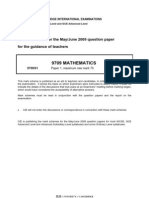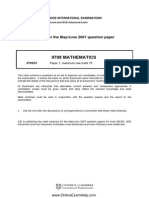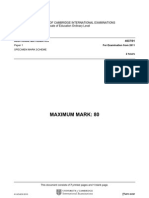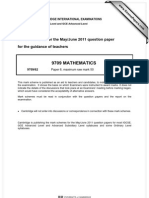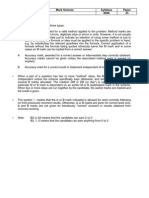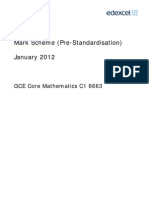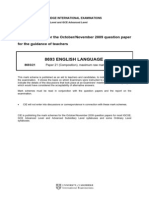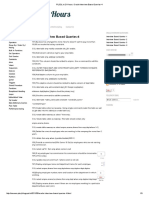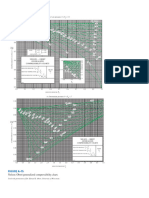4037 s10 Ms 12
4037 s10 Ms 12
Uploaded by
mstudy123456Copyright:
Available Formats
4037 s10 Ms 12
4037 s10 Ms 12
Uploaded by
mstudy123456Original Title
Copyright
Available Formats
Share this document
Did you find this document useful?
Is this content inappropriate?
Copyright:
Available Formats
4037 s10 Ms 12
4037 s10 Ms 12
Uploaded by
mstudy123456Copyright:
Available Formats
UNIVERSITY OF CAMBRIDGE INTERNATIONAL EXAMINATIONS
GCE Ordinary Level
MARK SCHEME for the May/June 2010 question paper for the guidance of teachers
4037 ADDITIONAL MATHEMATICS
4037/12 Paper 12, maximum raw mark 80
This mark scheme is published as an aid to teachers and candidates, to indicate the requirements of the examination. It shows the basis on which Examiners were instructed to award marks. It does not indicate the details of the discussions that took place at an Examiners meeting before marking began, which would have considered the acceptability of alternative answers. Mark schemes must be read in conjunction with the question papers and the report on the examination.
CIE will not enter into discussions or correspondence in connection with these mark schemes.
CIE is publishing the mark schemes for the May/June 2010 question papers for most IGCSE, GCE Advanced Level and Advanced Subsidiary Level syllabuses and some Ordinary Level syllabuses.
Page 2
Mark Scheme: Teachers version GCE O LEVEL May/June 2010
Syllabus 4037
Paper 12
Mark Scheme Notes Marks are of the following three types: M Method mark, awarded for a valid method applied to the problem. Method marks are not lost for numerical errors, algebraic slips or errors in units. However, it is not usually sufficient for a candidate just to indicate an intention of using some method or just to quote a formula; the formula or idea must be applied to the specific problem in hand, e.g. by substituting the relevant quantities into the formula. Correct application of a formula without the formula being quoted obviously earns the M mark and in some cases an M mark can be implied from a correct answer. Accuracy mark, awarded for a correct answer or intermediate step correctly obtained. Accuracy marks cannot be given unless the associated method mark is earned (or implied). Accuracy mark for a correct result or statement independent of method marks.
When a part of a question has two or more method steps, the M marks are generally independent unless the scheme specifically says otherwise; and similarly when there are several B marks allocated. The notation DM or DB (or dep*) is used to indicate that a particular M or B mark is dependent on an earlier M or B (asterisked) mark in the scheme. When two or more steps are run together by the candidate, the earlier marks are implied and full credit is given. The symbol implies that the A or B mark indicated is allowed for work correctly following on from previously incorrect results. Otherwise, A or B marks are given for correct work only. A and B marks are not given for fortuitously correct answers or results obtained from incorrect working. Note: B2 or A2 means that the candidate can earn 2 or 0. B2, 1, 0 means that the candidate can earn anything from 0 to 2.
UCLES 2010
Page 3
Mark Scheme: Teachers version GCE O LEVEL May/June 2010
Syllabus 4037
Paper 12
The following abbreviations may be used in a mark scheme or used on the scripts: AG BOD CAO ISW MR PA SOS Penalties MR 1 A penalty of MR 1 is deducted from A or B marks when the data of a question or part question are genuinely misread and the object and difficulty of the question remain unaltered. In this case all A and B marks then become follow through marks. MR is not applied when the candidate misreads his own figures this is regarded as an error in accuracy. Answer Given on the question paper (so extra checking is needed to ensure that the detailed working leading to the result is valid) Benefit of Doubt (allowed when the validity of a solution may not be absolutely clear) Correct Answer Only (emphasising that no follow through from a previous error is allowed) Ignore Subsequent Working Misread Premature Approximation (resulting in basically correct work that is insufficiently accurate) See Other Solution (the candidate makes a better attempt at the same question)
OW 1,2 This is deducted from A or B marks when essential working is omitted. PA 1 S 1 EX 1 This is deducted from A or B marks in the case of premature approximation. Occasionally used for persistent slackness usually discussed at a meeting. Applied to A or B marks when extra solutions are offered to a particular equation. Again, this is usually discussed at the meeting.
UCLES 2010
Page 4
Mark Scheme: Teachers version GCE O LEVEL May/June 2010 M1 M1 DM1 A1,A1 [5] M1 A1 A1 M1 A1 [5]
Syllabus 4037
Paper 12
24x2 6x = 0 (or y2 + 3y + 2 = 0)
1 leading to (0, 1) and ,2 4
M1 for attempt to get an equation in one variable. M1 for attempt to get 2 or 3 term quadratic = 0 DM1 for attempt to solve A1 for each pair of values M1 for substitution of x = 2 or 1, or verification A1 for each correct (allow unsimplified) M1 for attempt to solve A1 for a = 8, b = 13
6(2)3 + a(2)2 (a + 1)(2) + b = 15 6a + b = 61 when x = 1, 2a + b = 29 leading to a = 8 and b = 13
r 4 17 (i) AB = 5 25 21 = 20
B1
r B1 for AB
2129 unit vector = 20 or equivalent 29
r 17 21 (ii) OC = 3 25 20 r 46 OC = 35
r M1 for magnitude of AB M1, A1 [3]
M1 A1 [2] B1 M1 A1 [3]
r 17 M1 for + 3 AB 25
(i) gradient = 2 y2 = 2sec x + c leading to y2 = 2sec x + 6.4
B1 for gradient M1 for correct attempt to link y2 and sec x
(ii) when y = 2, cos x =
5 6
DM1 A1 [2]
DM1 for attempt to solve their equation using y = 2
gradient at A =
1 , 3 normal grad = 3 coords of A (3, 5) normal y 5 = 3(x 3) 14 when y = 0, x = 3
dy 3 = , dx x 2
M1
M1 for attempt to differentiate
DM1 B1 DM1 A1 [5]
DM1 for use of perp grads DM1 for attempt at normal
UCLES 2010
Page 5
Mark Scheme: Teachers version GCE O LEVEL May/June 2010 B1 B1 B1
Syllabus 4037 B1 for y = cos x
Paper 12
(a) (i)
x
2 4 6
0 B1 for either a translation of or 2 1 cycles B1 for correct curve
[3] B1 [1] B1 [1] B1 [1] M1 A2,1,0 [3] M1 for attempt to take logs and plot graph 1 for each error either in table or on graph. M1 for use of gradient [2]
(ii) 4 (b) (i) 5 (ii) 7 (i) lgv lgp 1 3.15 1.70 2.18 2.04 1.72 2.36 1.28
2 3
(ii) gradient = n = 1.37 (allow 1.32 to 1.42) (iii) p = 30 (allow 28 to 32)
M1 A1 M1 A1 [2]
M1 for use of graph or their equation
16 9 (i) 1 2
B1 B1 [2] B1 B1 [2] M1 A2,1,0 [3]
B1 at least 2 correct B1 all correct B1 for determinant B1 for matrix M1 for attempt at valid method 1 each error
(ii)
1 2 3 83 1 4
(iii) X = AB 5 12 = 0 8
UCLES 2010
Page 6
Mark Scheme: Teachers version GCE O LEVEL May/June 2010 M1, DM1 A1 [3]
Syllabus 4037
Paper 12
(i) 5 + 5 + 3 + 8 = 15.5 = 0.5 (ii) (3)2 : (8)2 (3)2 = 9 : 55
M1 for use of arc length DM1 for attempt to find perimeter
M1 for a sector area M1 M1 for attempt to find area of XABY DM1 DM1, A1 M1 for attempt to obtain ratio [4] B1 [1] B1, B1 [2] M1 B1, B1 A1 [4] M1 DM1 A1 [3] B1 B1 B1 [3] B1 B1 B1 [3] B1 for 6C5 4C2, B1 for 36 M1 for a correct method B1 for 4, B1 for 60
10
(i)
10
C7 = 120
(ii) 6C5 4C2 = 36 (iii) Need (6C + 1M) + (5C + 2M) + (4C + 3M) 4 + (ii) + (6C4 4C3) = 100 11 (i) 48 = 12 ln (2t + 3) 2t + 3 = e4 t = 25.8 (ii) x = 12 ln (2t + 3) 24 v= 2t + 3 when t = 1, v = 4.8 (iii) a =
48 (2t + 3) 2 when t = 1, a = 1.92
M1 for attempt to deal with logs DM1 for attempt to solve
1 2t + 3 B1 24
B1
B1 for 4.8 B1 for
1 (2t + 3) 2 B1 on 24 B1 for 1.92
UCLES 2010
Page 7
Mark Scheme: Teachers version GCE O LEVEL May/June 2010
Syllabus 4037
Paper 12
12 EITHER (i) y = 4 sin 2x + c
passes through ,7 , c = 3 4
M1 M1 A1 [3] M1 M1 A1 A1 [4] M1 A1 DM1
M1 for attempt to integrate M1 for attempt to get c provided a function of sin 2x is used
(ii) 5 = 4 sin 2x + 3 0.5 = sin 2x 5 x= , 12 12 (iii)
M1 for attempt to equate to 5 and solve M1 for a correct method to find x A1 on first solution M1 for attempt to integrate
5 12 12
4 sin 2x + 3dx
5 12 12
[ 2 cos 2 x + 3x]
=+2 3
DM1 for correct use of limits M1 for area of rectangle [5]
Shaded area = + 2 3 (= 1.37) 12 OR (i) y = 2e3x 12x + c
5 3
M1 A1
M1, A1 M1, A1 [4] M1 A1, A1 [3]
Passes through (0, 1), so c = 1 (ii) 6e3x 12 = 0
M1 for attempt to integrate, condone omission of c M1 for attempt to obtain c M1 for attempt to solve
leading to x =
1 ln 2 and y = 3 4 ln 2 3 (allow (0.231, 0.227)
d2 y = 18e3x, always +ve so min 2 dx
(iii)
M1, A1 M1 for a complete, correct method [2] M1 DM1 A1 [3] M1 for attempt to get equation of tangent at (0, 1) DM1 for substitution of y = 0
(iv) at (0, 1), gradient = 6 tangent : y 1 = 6(x 0) when y = 0, x =
1 6
UCLES 2010
You might also like
- HESI A2 Math Practice Tests: HESI A2 Nursing Entrance Exam Math Study GuideFrom EverandHESI A2 Math Practice Tests: HESI A2 Nursing Entrance Exam Math Study GuideNo ratings yet
- 9709 Mathematics: MARK SCHEME For The May/June 2011 Question Paper For The Guidance of TeachersDocument6 pages9709 Mathematics: MARK SCHEME For The May/June 2011 Question Paper For The Guidance of TeachersJia SyuenNo ratings yet
- Data Interpretation Guide For All Competitive and Admission ExamsFrom EverandData Interpretation Guide For All Competitive and Admission ExamsRating: 2.5 out of 5 stars2.5/5 (6)
- 4037 w09 Ms 1Document7 pages4037 w09 Ms 1mstudy123456No ratings yet
- 9709 Mathematics: MARK SCHEME For The May/June 2008 Question PaperDocument7 pages9709 Mathematics: MARK SCHEME For The May/June 2008 Question PaperYaviish CullenNo ratings yet
- 4037 w11 Ms 13Document8 pages4037 w11 Ms 13mstudy123456No ratings yet
- 0606 w10 Ms 12Document7 pages0606 w10 Ms 12Khoo Kian ChaiNo ratings yet
- 9709 s09 Ms 1Document6 pages9709 s09 Ms 1Thapa GorkhaNo ratings yet
- 0606 w10 Ms 11Document7 pages0606 w10 Ms 11Khoo Kian ChaiNo ratings yet
- 9709 s05 Ms 1Document9 pages9709 s05 Ms 1Halıl UskuriNo ratings yet
- 9709 s07 Ms 1 PDFDocument6 pages9709 s07 Ms 1 PDFtess_15No ratings yet
- A Level Maths November 2012 Mark Scheme 12Document7 pagesA Level Maths November 2012 Mark Scheme 12Kelvin MuzaNo ratings yet
- Maximum Mark: 80: University of Cambridge International Examinations General Certificate of Education Ordinary LevelDocument8 pagesMaximum Mark: 80: University of Cambridge International Examinations General Certificate of Education Ordinary LevelSutoyo SudNo ratings yet
- 4037 w12 Ms 22 PDFDocument7 pages4037 w12 Ms 22 PDFAsha D'saNo ratings yet
- 9709 w10 Ms 11Document7 pages9709 w10 Ms 11Joseph Dj-mo KellyNo ratings yet
- 9709 s05 Ms 1 PDFDocument9 pages9709 s05 Ms 1 PDFtess_15No ratings yet
- 4037 s05 Ms 2Document9 pages4037 s05 Ms 2Sherlock Wesley ConanNo ratings yet
- 4037 s07 Ms 1Document8 pages4037 s07 Ms 1mstudy123456No ratings yet
- 9709 s11 Ms 12Document7 pages9709 s11 Ms 12Diksha KoossoolNo ratings yet
- Mark Scheme Syllabus Mathematics - June 2003 9709Document42 pagesMark Scheme Syllabus Mathematics - June 2003 9709Iqra JawedNo ratings yet
- Math 9709 - s11 - Ms - 62Document6 pagesMath 9709 - s11 - Ms - 62purni.mnath4574No ratings yet
- 9709 s10 - ms31Document118 pages9709 s10 - ms31ShoummaShamsNo ratings yet
- 9231 s14 Ms 11Document10 pages9231 s14 Ms 11Cheah Jun SiangNo ratings yet
- 0606 s13 Ms 22Document9 pages0606 s13 Ms 22Fred HarrisonNo ratings yet
- 9709 w03 MsDocument33 pages9709 w03 Msmichael hengNo ratings yet
- 4037 s12 Ms 21Document8 pages4037 s12 Ms 21mstudy123456No ratings yet
- 9709 w15 Ms 12 PDFDocument7 pages9709 w15 Ms 12 PDFyuke kristinaNo ratings yet
- 0606 w10 Ms 22Document7 pages0606 w10 Ms 22Khoo Kian ChaiNo ratings yet
- 9709 s13 Ms 73 PDFDocument6 pages9709 s13 Ms 73 PDFDiksha KoossoolNo ratings yet
- 9709 Oct Nov 2011 All Mark SchemesDocument130 pages9709 Oct Nov 2011 All Mark SchemesRaisa Binte Huda100% (1)
- Mark Scheme Syllabus Mathematics - June 2003 9709Document42 pagesMark Scheme Syllabus Mathematics - June 2003 9709wircexdjNo ratings yet
- 0606 s03 Ms 1+2Document14 pages0606 s03 Ms 1+2Wong Kah Kei JoyceNo ratings yet
- 9709 Mathematics: MARK SCHEME For The May/June 2008 Question PaperDocument7 pages9709 Mathematics: MARK SCHEME For The May/June 2008 Question Papershin nakaNo ratings yet
- 9709 s08 Ms 1 PDFDocument7 pages9709 s08 Ms 1 PDFRayYongNo ratings yet
- 9709 w12 Ms 33Document7 pages9709 w12 Ms 33Nicholas TehNo ratings yet
- 9231 w12 Ms 11Document12 pages9231 w12 Ms 11Christopher BarrettNo ratings yet
- 9709 s03 Ms 1+2+3+4+5+6+7Document42 pages9709 s03 Ms 1+2+3+4+5+6+7Roukaiya Peerkhan50% (4)
- June 2010 (v2) MS - P1Document6 pagesJune 2010 (v2) MS - P1mahtabsilvercraftNo ratings yet
- 9709 Mathematics: MARK SCHEME For The May/June 2009 Question Paper For The Guidance of TeachersDocument8 pages9709 Mathematics: MARK SCHEME For The May/June 2009 Question Paper For The Guidance of TeachersSeleine ChongNo ratings yet
- 9709 w09 Ms 32Document7 pages9709 w09 Ms 32Alex Antia0% (1)
- 2013 Secondary 4 - Add Math - Sa1 - Paper 2 MsDocument8 pages2013 Secondary 4 - Add Math - Sa1 - Paper 2 Msapi-233271416No ratings yet
- 2013 June 0606 - 12 Paper 1 MSKDocument9 pages2013 June 0606 - 12 Paper 1 MSKKim Yen GohNo ratings yet
- June 2013 (v1) MS - P1Document7 pagesJune 2013 (v1) MS - P1VannyyyNo ratings yet
- C1 January 2012 Mark SchemeDocument17 pagesC1 January 2012 Mark SchemegerikaalhuNo ratings yet
- 9709 s15 Ms 12Document7 pages9709 s15 Ms 12Andrian M YusufNo ratings yet
- 9709 Mathematics: MARK SCHEME For The March 2016 SeriesDocument6 pages9709 Mathematics: MARK SCHEME For The March 2016 Seriesjoelk.brown15No ratings yet
- 4037 w21 Ms 12Document25 pages4037 w21 Ms 12Zahra LamiaNo ratings yet
- 9709 s15 Ms 72 PDFDocument6 pages9709 s15 Ms 72 PDFSanthiKalyanaGrantNo ratings yet
- 9709 w11 Ms 32Document7 pages9709 w11 Ms 32Helen B. EvansNo ratings yet
- 9709 w05 Ms 1Document7 pages9709 w05 Ms 1Roukaiya PeerkhanNo ratings yet
- Analytic Geometry: Graphic Solutions Using Matlab LanguageFrom EverandAnalytic Geometry: Graphic Solutions Using Matlab LanguageNo ratings yet
- Real Estate Math Express: Rapid Review and Practice with Essential License Exam CalculationsFrom EverandReal Estate Math Express: Rapid Review and Practice with Essential License Exam CalculationsNo ratings yet
- Practice Makes Perfect in Geometry: Angles, Triangles and other Polygons with AnswersFrom EverandPractice Makes Perfect in Geometry: Angles, Triangles and other Polygons with AnswersNo ratings yet
- 0654 w04 Ms 6Document6 pages0654 w04 Ms 6mstudy123456No ratings yet
- 0486 w09 QP 4Document36 pages0486 w09 QP 4mstudy123456No ratings yet
- 0547 s06 TN 3Document20 pages0547 s06 TN 3mstudy123456No ratings yet
- Frequently Asked Questions: A/AS Level Sociology (9699)Document1 pageFrequently Asked Questions: A/AS Level Sociology (9699)mstudy123456No ratings yet
- Literature (English) : International General Certificate of Secondary EducationDocument1 pageLiterature (English) : International General Certificate of Secondary Educationmstudy123456No ratings yet
- 9701 s06 Ms 4Document5 pages9701 s06 Ms 4Kenzy99No ratings yet
- 9694 w10 QP 23Document8 pages9694 w10 QP 23mstudy123456No ratings yet
- 9694 s11 QP 21Document8 pages9694 s11 QP 21mstudy123456No ratings yet
- 8693 English Language: MARK SCHEME For The October/November 2009 Question Paper For The Guidance of TeachersDocument4 pages8693 English Language: MARK SCHEME For The October/November 2009 Question Paper For The Guidance of Teachersmstudy123456No ratings yet
- University of Cambridge International Examinations General Certificate of Education Advanced LevelDocument2 pagesUniversity of Cambridge International Examinations General Certificate of Education Advanced Levelmstudy123456No ratings yet
- 8679 w04 ErDocument4 pages8679 w04 Ermstudy123456No ratings yet
- 9719 SPANISH 8685 Spanish Language: MARK SCHEME For The May/June 2009 Question Paper For The Guidance of TeachersDocument3 pages9719 SPANISH 8685 Spanish Language: MARK SCHEME For The May/June 2009 Question Paper For The Guidance of Teachersmstudy123456No ratings yet
- First Language Spanish: Paper 8665/22 Reading and WritingDocument6 pagesFirst Language Spanish: Paper 8665/22 Reading and Writingmstudy123456No ratings yet
- English Language: PAPER 1 Passages For CommentDocument8 pagesEnglish Language: PAPER 1 Passages For Commentmstudy123456No ratings yet
- Quiz Bank PDFDocument27 pagesQuiz Bank PDFAmna RamzanNo ratings yet
- Triassic PG2003Document11 pagesTriassic PG2003Sabrina TorchiaNo ratings yet
- wch14 01 Rms 20240815Document34 pageswch14 01 Rms 20240815Sashikala NagendranNo ratings yet
- Distillation Boiling Point DeterminationDocument5 pagesDistillation Boiling Point DeterminationBryanNo ratings yet
- 1.1 FunctionsDocument2 pages1.1 Functionsm kNo ratings yet
- Inventorwizard: Miniature Model Engine 6 Cylinder - Radial Engine (Pneumatic) Assembly CrankshaftDocument24 pagesInventorwizard: Miniature Model Engine 6 Cylinder - Radial Engine (Pneumatic) Assembly CrankshaftKris TolentinoNo ratings yet
- MGMT 3106 Assignment 02Document4 pagesMGMT 3106 Assignment 02UdekdmarsNo ratings yet
- 9 XSag CAr 1 DTSYgaa ZZCJDocument14 pages9 XSag CAr 1 DTSYgaa ZZCJdeepavadivel1979No ratings yet
- 20XW15 - Problem Solving and C ProgrammingDocument19 pages20XW15 - Problem Solving and C ProgrammingHead LightNo ratings yet
- Exam2 2004Document17 pagesExam2 2004Hazem AlmasryNo ratings yet
- Barclays ExpDocument15 pagesBarclays ExpSarang GhodeNo ratings yet
- Book Back All One Word Questions and Answers CSCDocument5 pagesBook Back All One Word Questions and Answers CSCsdnsdfNo ratings yet
- The Nature of Regression AnalysisDocument20 pagesThe Nature of Regression AnalysisEsaie GuemouNo ratings yet
- NATM Siddharth PatelDocument38 pagesNATM Siddharth PatelSiddharth PatelNo ratings yet
- 00Document40 pages00ShōyōHinataNo ratings yet
- Use of The ISO 9308-1 Procedure For The DetectionDocument10 pagesUse of The ISO 9308-1 Procedure For The Detectionahmad munawirNo ratings yet
- A Report On Plug ComputerDocument22 pagesA Report On Plug ComputeriamvarkeyNo ratings yet
- 1199 4501 1 PBDocument6 pages1199 4501 1 PBabdul qadirNo ratings yet
- PLSQL in 21 Hours - Oracle Interview Based Queries-4Document3 pagesPLSQL in 21 Hours - Oracle Interview Based Queries-4Manohar ReddyNo ratings yet
- Piping Class - AC21Document2 pagesPiping Class - AC21Дмитрий РыбаковNo ratings yet
- Polynomial FunctionsDocument9 pagesPolynomial FunctionsLaurenzhen SorianoNo ratings yet
- Gujarat Technological UniversityDocument2 pagesGujarat Technological UniversityJag Parvesh DahiyaNo ratings yet
- Thermodynamics An Engineering Approach 9e by Yunus Çengel-1Document1 pageThermodynamics An Engineering Approach 9e by Yunus Çengel-1bilalahmedkamboh8No ratings yet
- Practice Set 3 (B)Document8 pagesPractice Set 3 (B)Willis ChekovNo ratings yet
- 1Z0-062 Exam Dumps With PDF and VCE Download (1-30) PDFDocument17 pages1Z0-062 Exam Dumps With PDF and VCE Download (1-30) PDFHumberto Cordova GallegosNo ratings yet
- XSLT TutorialDocument19 pagesXSLT Tutorialapi-19921804No ratings yet
- Torsion Module 6 With SolutionsDocument26 pagesTorsion Module 6 With Solutionsmaran.suguNo ratings yet
- Figure 1 Shows A Malignant Tumour in The Trachea of A PatientDocument9 pagesFigure 1 Shows A Malignant Tumour in The Trachea of A PatientJohn SmithNo ratings yet
- Chapter2.3-CPU Sched - QeuestionDocument7 pagesChapter2.3-CPU Sched - QeuestionNguyễn Trí DũngNo ratings yet
- Meteorological Factors Affecting Air PollutionDocument31 pagesMeteorological Factors Affecting Air PollutionreyaNo ratings yet








